
Mariha-kitchen/iStock/Getty Images
Lentils may have been one of the first agricultural crops grown, with cultivation beginning more than 8,500 years ago, researchers from the Universities of Wisconsin and Minnesota report. Both lentils and rice have been food staples for many centuries. Eaten together, they offer a low-fat, nutritious source of complete protein, fiber, iron and other essential minerals.
Definition
Rice is the seed of a plant called Oryza sativa. Available in different grain sizes, the Food website explains that long-grain rice is light and separates easily when cooked, while short-grain rice has a higher starch content that makes it stickier. The lentil, a plant called Lens culinaris, contains seeds that can be eaten whole or sprouted.
Nutritional information in this article comes from the U.S. Department of Agriculture, as relayed by the eLook website. The serving size is 1 cup cooked, for both lentils and unenriched white rice.
Basic Nutrition
One cup of white rice contains 199 calories; the same serving of lentils has 229. Rice is fat free; lentils have only 1 gram of total fat. They both contain 4 to 5 milligrams of sodium, an amount so low it does not register as a percentage of the daily value for a 2,000 calorie-a-day diet. White rice is low in fiber, at 1 g per serving; lentils, however, contain 16 g of dietary fiber.
Vitamins and Minerals
Eaten together, rice and lentils provide thiamin (0.38 mg), riboflavin (0.18 mg), niacin (4.55 mg), vitamin B6 (0.38 mg) and pantothenic acid (1.87 mcg). Lentils alone are a rich source of folate, packing 358.38 micrograms per serving, or 89 percent of the recommended daily value, eLook reports. Lentils also provide vitamin C (2.97 mg) and vitamin K (3.37 micrograms).
Rice and lentils contain all the essential dietary minerals, but in significantly different amounts. Lentils are a great source of iron (6.59 mg; 36 percent of daily value), magnesium (71.28 mg; 17 percent), phosphorus (356.4 mg; 17 percent), potassium (730.62 mg; 30 percent), zinc (2.5 mg; 16 percent), manganese (0.9 mg; 48 percent) and copper (0.49 mg; 24 percent). Rice offers more selenium (14.35 micrograms; 20 percent), and both provide about the same amount of calcium (33-37 mg; 3 percent each).
Protein
A complete protein is one that provides all the essential amino acids in the proper amounts. When eaten together, rice and lentils create a complete protein. Though lentils are slightly low in two amino acids, they contain one of the highest amounts of protein found in plants, according to the University of Maryland Medical Center. One cup of lentils has 18 g, or 35 percent of the daily value of protein.
Glycemic Values
The glycemic index indicates the impact of carbohydrates on blood sugar levels; the higher a food's number, the more it increases blood sugar. On a scale where 100 is pure sugar (glucose), white rice has a glycemic index of 64, while lentils are low on the index with a rating of 29, Oregon State University's Linus Pauling Institute reports.
Considerations
Some nutritional values increase if you use brown rice. Compared to unenriched white rice, brown rice has four times the fiber, five times more thiamin, eight times more vitamin B6 and three to four times more iron, magnesium, phosphorus and manganese.
Related Articles
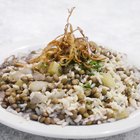
Do Lentils & Rice Have Calcium & ...

Nutrition From Beans & Rice

Is Jasmine Rice Naturally White or Is ...
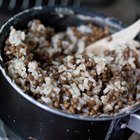
Rice & Lentil Diet

How to Freeze Lentils

How Long After a Sell-By Date Can You ...
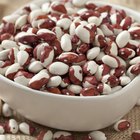
The Nutritional Value of Anasazi Beans ...

How to Cook Japanese Rice

Is Soy Milk Casein-Free?

How to Cook Golden Rose Rice

The Nutrition of 15-Bean Soup
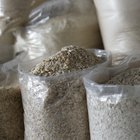
How to Cook Rice Flakes

Differences Between Steamed & Boiled ...

Nutrition and Protein in Rice

Vitamin B2 for Hair Growth

How to Make Rice With a Bamboo Steamer

Can You Use Corn Meal to Make Tamales?

How to Cook Rice in Foil

Does Rice Taste Different Depending on ...
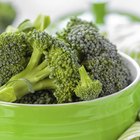
Foods Rich in Magnesium & Phosphorus
References
Writer Bio
Sandi Busch received a Bachelor of Arts in psychology, then pursued training in nursing and nutrition. She taught families to plan and prepare special diets, worked as a therapeutic support specialist, and now writes about her favorite topics – nutrition, food, families and parenting – for hospitals and trade magazines.
Photo Credits
Mariha-kitchen/iStock/Getty Images